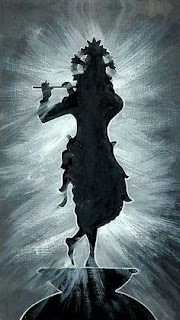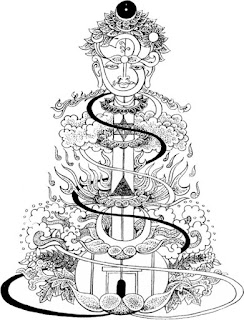Behind the ritual
Its really hard to teach or explain the philosophical implications of the rituals and narratives of Sanatana-dharma. Being deeply infused with meaning at every level, the question arises, where do I even start? For without understanding, rituals are empty, and without ritual change is difficult.
The Purana generally begin by telling a story of sages meeting at the dawn of Kali-yuga(The iron age, our current epoch) to discuss solutions to the future of mankind and the earth itself. Tales are told of past and future to form a practical means by which mankind can find refuge during the darkest age of all.
This discussion turns to elaborate explanations of the evolution, sustenance, and dissolution of the cosmos. The descriptions of the primary elements of life and their ruling Devata(light beings or Demigods)This knowledge is called Sankhya, or metaphysics.
Then this knowledge is practically applied as a map or explanation of the barriers consciousness must bypass through yogic practice in order to clearly perceive the immutable and irreducible Self. The explanation of postures, breathing exercises, seals, locks, and trance mechanics leading to the state called Laya or meditative absorption and the awakening of the energy called . Laya being the microcosmic form of Pralaya(the ultimate annihilation at the end of the life time of a universe) it is a form of yogic ego death, wherein the elemental material constituents of the body/mind are successively dissolved into one another until the only thing life for perception is perception of perception, pure consciousness. This knowledge is called Yoga, and through it the yogi perceives and adores the supreme soul, the cosmic being within the heart of all, called Paramatma.
Then the knowledge directly dealing with that sublime substance known as Self, or Brahman. Wherein, we are taught the true nature of each and every soul. Every soul is a portion of Jnana or knowledge, intrinsically made of knowing, knowership, and the known itself. These spark like individuals souls are part and parcel of the the great Paramatma, the Absolute Consciousness beyond individual locality, yet localised in each individual as its life and life force. This knowledge is realised through repetitive and complete yogic absorption, laya, into the self, through yoga and samyama(the meditative triad of Dharana or holding, dhyana or fixed mind, and samadhi or total absorption.)
Finally discussions on Bhakti which seeks to give access to the supreme in a very humanistic, simple, and easy way. Seeing the Cosmic being, in the form of owns chosen Ishta devata(For Vaishnavas this is a form like Narayana, Narasimha, Krsna, or one of the other Dasa avatar, for Gaudiya Vaishnavas it is exclusively Sri Radha-Krsna)
This process helps the Sadhaka to develop the fifth and final goal of life called Prema bhakti or unalloyed pure Devotion. The state in which one experiences complete and utter ecstasy accompanied by the eight signs of ecstasy and the attainment of the direct vision and interaction with ones Ista-deva, being filled with love and bliss through acts of service towards him.
This state is different from the absorption of Jnani's and Yogi's who through their meditative absorption and introspection attain the Peaceful mellows vision and experience of the Supreme. Santa-rasa is the state of Neutral appreciation or "the peaceful mellow" and the bliss of that state is incomparable in the three worlds, however, that state of Santa progressively sweetens and intensifies as it gets closer to the higher mellows such as friendship, parental affection, and lover.
That being said, Santa-rasa is essentially the stepping stone to higher stages of self realising Self, without which, it is impossible to actually appreciate the higher mellows because one will be seeking something for oneself. Santa rasa is abiding in the innate perfection of being, without attempting to alter or strive for anything outside of ones Self.
In terms of Geographic/metaphysical location, this is Kailash. The Abode of Sadasiva the embodiment of Santa-rasa.
In the Gaudiya Pancha tattva(A group of Five principle truths of devotion, embodied as Sri Krsna Chaitanya and his four main associates), the Two personalities Sri Advaita(Literally non-duality personified) and Sripad Nityananda Avadhuta(The incarnation of the Bliss arising from the realisation of owns innate eternity, purity, and connection to the supreme soul) give Santa-rasa to their devotees as well as the entrance into divine service, friendship, and some tinges of parental mellows.
Bhakti yoga, is not merely a process of developing a devotional sentiment towards the Divine. It is the complete system of relating to the supreme through owns body, speech, and mind. It is the post Self-realisation activity of the awakened masters, who perpetually engage with their life, in the form of their Ista devata, Bhagavana and Bhagavati, Sri Sri Radha Krsna, and thus derive and share the highest bliss with them.
The process of ascending the ladder of Karma, Yoga, Jnana, and Bhakti is collectively known as Tantra. For a Vaishnava this Tantra is called Pancharatra.
This is the system I was taught by my mentors, gurus, and experiential learning through practice and introspection. This is the essence of Sanatana-Dharma according the Vaishnava view.
Until next time, Jai Nitai!
Nitai's wine cup
Vishuddha Sattva is always drinking the wine of Prema-rasa
How much can be said about that Dark connoisseur, delighted by himself
How much can be said about that golden maiden of Devotion, absorbed in his satisfaction
Drinking too much, Their eyes roll and speech slur
They then shared that beverage without consideration
Nilamani says "Oh Nitai, pass the wine cup and let me drink the nectar of Devotion, for then I will know you in love rather than truth"



Nice one
ReplyDelete